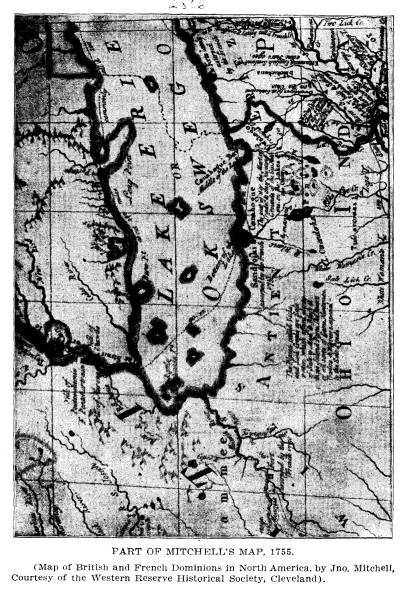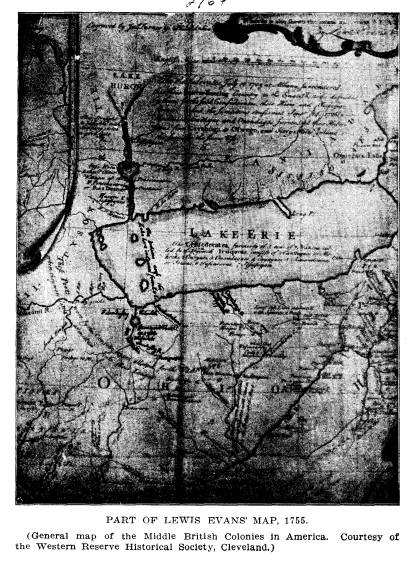Ohio History Journal
OLD FORT SANDOSKI
OF 1745.
G. FREDERICK WRIGHT,
President Ohio State Archaeological
and Historical Society.
Mr. Charles A. Hanna's criticism of the
inscription on the
tablets placed on the site of Old Fort
Sandusky and of the ad-
dresses made at the unveiling of these
tablets, are too serious
to be permitted to pass without
correction.
First-Mr. Hanna's loose habit of
observation (?) may be
inferred from his first statement that
the bronze tablet on the
West Face was "erected under the
direction of the Ohio State
Historical Society," quoting the
inscription in full, all but the
concluding sentence which Mr. Hanna
fails to quote, but which
reads, "Erected by the Ohio Society
Colonial Dames of
America." The inscription is
correct in every detail.
Second-His carelessness in observing the
facts in the case
appears in his next statement that,
"The first and only Fort
erected near this spot or on the north
shore of Sandusky Bay
was built by the French in the winter of
1750 and
1751, as
stated-in De Lery's Journal of
1754," and that "The British
never built a Fort on the north side of
Sandusky Bay."
What De Lery really wrote in his diary
August 4th, 1754,
(See Ohio Archaeological and Historical
Quarterly, Vol. 17,
page 377), was, "I did not know
where the portage was. I
imagine that some vestiges still remain
of the Fort the French
(sic) had built in 1751, and which was
afterwards evacuated. To
find it, I followed the shore on the
north side of said lake which
runs east and west, after proceeding
about three leagues, I
found a clearing where I landed at noon
and discovered the
ruins of the old Fort."
There is here no denial of the previous
occupation of the
Fort by the English.
The tablet further reads, "Rebuilt
by British in 1750 and
usurped by the French in 1751." The
authority for this is found
(371)
|
372 Ohio Arch. and Hist. Society Publications. |
|
|
Old Fort Sandoski of 1745 and The Sandusky Forts. 373
in Mitchell's map published in 1755
which locates the Fort at
the point where the tablet is erected,
and adds, "Usurped by the
French in 1751." Who, but the
British, does Mr. Hanna sup-
pose, was in possession of this place,
in 1751, when the French
"usurped" it? With reference
to the authority of Mitchell's
map, it is sufficient to say that its
correctness was certified to
by John Pownall, Secretary of the Board
of Trade of Virginia,
July 1st, 1755, and that it is the map
used by Commissioners of
the United States and Great Britain in
the Treaty of Peace
in 1783.
Third-The next mistake of Mr. Hanna is
his statement
that "The first British Sandusky
Fort was built on the south side
of the Bay by a company of British
soldiers and artisans under
command of Lieutenant Elias Meyer, in
1761." This shows
both Mr. Hanna's ignorance of the
locality of which he is wri-
ting, and his lack of close attention to
the authorities which he
quotes. If he had noted carefully the
statement in DeLery's
Journal, printed in Vol. 17, page 357,
he would have learned
that during high water, the Portage
across the neck of the
Marblehead Peninsula, was under water
much of the time, thus
making an island "almost in the
middle of the little Lake San-
dusky." DeLery's first notes were
made on his westward
journey on August 4th, 1754.
On his return from Detroit about
the middle of March, 1755, he writes,
after crossing the River
Portage, "I went on to Lake Sandoske
to see whether we could
cross it either in a canoe or on the
ice. I arrived there at half-
past six o'clock, after walking
continually in the water of which
the Portage is full at that season. I
found the lake clear of ice."
This was the place "almost in the
middle of the little Lake San-
dusky," where Lieutenant Elias
Meyer writes that, "The block-
houses and palisades were finished Nov.
29, 1761," and where
the men under Ensign Pauli were
massacred by Pontiac's
minions May 18, 1763, in the British
Fort Sandoski on the north
side of Lac Sanduski, which now is
marked by enduring bronze
tablets.
Fourth-Mr. Hanna's statement that,
"The White River"
from which the five French traders were
returning when they
were massacred by Nicholas in the spring
of 1747, was the Cuya-
|
374 Ohio Arch. and Hist. Society Publications. |
|
|
Old Fort Sandoski of 1745 and The
Sandusky Forts. 375
hoga River is a mere assertion without
any foundation in fact.
Neither Colonel Whittlesey, Mr. A. T.
Goodman nor Judge Bald-
win, long officers of the Western
Reserve Historical Society at
Cleveland, on the Cuyahoga River, and
all extremely anxious to
prove the importance of their own
locality, ever thought of
claiming the Cuyahoga River for the
White River.
From the foregoing, it appears that Mr.
Hanna's criticism
betrays such carelessness in the use of
data which were plainly
before his eyes that no confidence can
be placed in his general
statements when unsupported by definite
references and that,
when definite references are made, it is
not likely that he has
considered them carefully enough to give
them proper interpre-
tation.
The experiences of Secretary Randall in
his "History of
Ohio," in dealing with the
sophistries of Mr. Hanna in trying
to prove that LaSalle did not discover
the Ohio, brings out Mr.
Hanna's defects of historical judgment.
Reviewing Hanna's
argument in the case of LaSalle, Randall
says, "they are mainly
negative and leave LaSalle's claim still
unrefuted with the pre-
ponderance of evidence decidedly in his
favor, and the judgment
of Parkman still unreversed that LaSalle
discovered the Ohio."
A critic who can in a nonchalant manner
dismiss the con-
clusions of Parkman, discredit the
conversations published by
Margry, doubt the correctness of
LaSalle's "Memorial to Fron-
tenac," think that Joliet's map was
a species of forgery, and
that the opinion of Whittlesey, Goodman
and Baldwin of the
Western Reserve Historical Society, are
of no value in the
history of the regions to which they
each give their close atten-
tion, is not one whose opinions are to
be taken without investiga-
tion.
STATEMENT BY THE EDITOR OF THE
QUARTERLY.
The Editor is responsible for the
publication, without cor-
rection, or comment, in the last
QUARTERLY of the article
by Charles A. Hanna making severe
reflection on the Presi-
dent and Trustees of the Ohio State
Archaeological and His-

